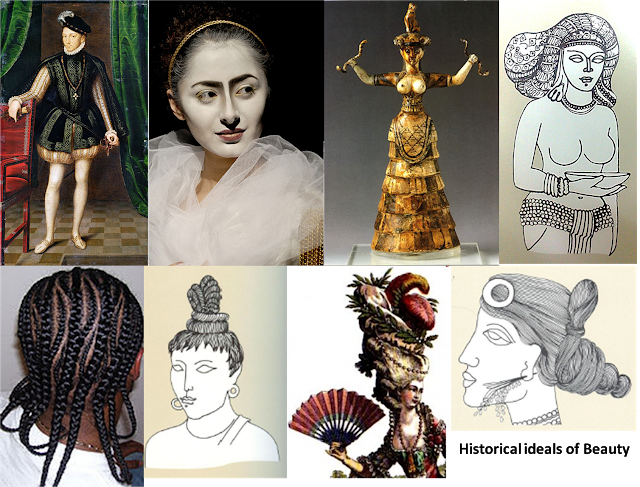What is beauty? Who is beautiful?
These are questions I ask students after they complete my semester and a half long course on Costume Appreciation, where we discuss the aesthetics, beautification processes, and attire worn by people around the globe. For me, it is the single most thought provoking discussion that a fashion school can and must have and after a lot of thought, I am sharing my views on different Ideals of beauty here.
History teaches us that there is no one yardstick for measuring beauty and how Various ideals of beauty have evolved over time. In some cultures, spotless white or black skin is the ideal of beauty while in some other tattooed or painted skin is considered beautiful. Some prefer no accessories while other elongate necks and earlobes with jewelry. Some think anklets indicate slavery while other think they celebrate free-spirited nature. With the passing of time, different cultures have borrowed from each other, amalgamating their ideals with those that contradict them, leading to rich cultural practices.
The impact of Colonisation
 |
| Image from Basics: Fashion design – Jewellery design by Elizabeth Glaton; book review coming up soon |
In the past, European women, applied lead powder on their faces as paleness was considered the epitome of beauty and in the process suffered painful cancers. Hindu, Tamil Brahmin women used to apply turmeric on their face and hands as yellow was considered as the auspicious (mangalagaram) mark of a married woman (Sumangali). Marie Antoinette’s powdered hair is legendary along with the staggeringly high fruit and feather coiffures of the18th century noblewomen which would be inhabited by mice and vermin. Until the mid 90’s only curvy women were considered sexy in Indian movies with 2000’s Ideals of beauty giving way to anorexic models.
Who is to say what is right? In this age of extensive and often extreme grooming does the concept of Saamudrika Lakshanam hold good?
Identity and gender
One of the main functions of fashion is gender identification and differentiation but how can we define how a man or woman should look without considering the context of the civilization, the geographic, demographics and the evolution of the culture?

Lord Krishna, the best strategist and one of the most handsome Gods is said to have had radiant blue-black skin, lotus pink lips and he is described in epics as wearing bright yellow silks with pearl and diamond jewelry and sometimes a nose ring. A very famous Cretan sculpture shows a powerful goddess holding up snakes with her breasts spilling over her jacket. In the high Gothic period wearing a hose that came over the mid thigh with velvet breeches was considered as manly perfection. A very famous Cretan sculpture shows a powerful goddess holding up snakes with her breasts spilling over her jacket. On a more relatable level, I remember my grand uncles having long hair (similar to a back oseldet) and wearing chunky diamond studs in both ears as a part of their tradition. I have seen male traders wearing nail polish and Mehendi even today and I know of women who’ll only wear all black or blue outfits.
 |
| Photo: Kritarth Ghosh, Model: Adhithi Priya, Headgear: Divya N, Concept: Birth of Colors |
Ideals of beauty
Today, our societies, our nations and hence our practices are in a constant flux. Living in this melting pot of cultures, we are racing towards frontiers and embracing technology as our second skin but we are still not open to breaking stereotypes and challenging falsely conceived notions. At a time when leggings are being considered as destructors of culture, are we willing to call a man wearing a pantyhose and gathered velvet shorts as manly? Are we open minded enough to see him wearing yellow silks, a nose ring, flowers and pearls? Should a woman be completely covered up to be a “good, respectable woman”? Can a plus sized or even large women wear short, fitting clothes without being ridiculed? Why is a girl considered feminine only when she wear pinks, pearls or flowers? Why is there is constant debate whether the fair or dark skin is more beautiful?
Be You
I understand that this is sensitive (and controversial) topic with exhaustive arguments from either side of the bench. But the fact that there is a discussion itself is a positive development for me. I feel that Fashion brands, designers and enthusiasts have a responsibility to make this society more open minded and aware and accepting of the fact that we are all created equal. No one being should ever be made to feel that they are less than another for looking a particular way. I laud Jabong‘s sequel to their “Be You‘ Campaign that discusses alternative ideals of beauty and questions stereotypes as a positive step in this direction.
Without going into the commercial or strategic aspect of branding, I think this one of the best fashion advertisements of recent times in terms of content – styling and choreography. Controversial as it might be, it is interesting to see the Indian advertising industry transform into this mature, complex visual medium. It makes you sit up, take notice and propels you to discuss real yet scarcely discussed issues like “identity” and Ideals of beauty in a contemporary Indian Context.
Recently, I found this post on Facebook that said “One’s choices may not resonate with you! But that does not make them wrong!”. I don’t think I can sum up this post any better. One does not have to conform to a particular way of looking to be considered beautiful. With a little awareness, acceptance, and kindness everyone can live beautiful lives!
PS: This is not a sponsored post.
I hope you found it interesting
Cheers



